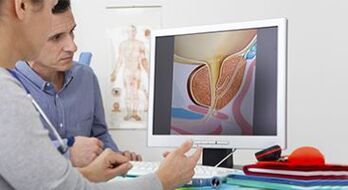Prostatitis and prostate tumors are diseases commonly diagnosed in men. It is not surprising that men are concerned with their symptoms and other characteristics. Let's find out how these conditions differ and how they are treated.

Prostatitis and prostate tumors are diseases commonly diagnosed in men.
What is the difference between prostatitis and prostatitis?
In fact, there are enough differences.
They relate to the following factors:
- Time of onset of the disease.Prostate tumors are usually diagnosed in men between the ages of 45-50, and prostatitis is also problematic for younger members of the male population.
- The first symptoms.As a rule, with prostatitis, patients complain of discomfort (including rather pronounced pain), and with adenomas, urinary disorders.
- The reasons.Prostatitis is an inflammatory process and can be triggered by an infection of the genital tract and prostate gland which is an overgrowth of tissue due to various factors.
- Clinical picture.Acute prostatitis is often accompanied by chills and fever, and adenomas progress without signs of infection.
- The nature of the pain.Inflammation is manifested by acute pain in the groin, perineum, and rectum. Tumors in the early stages may not appear in any way. Even when pain occurs, it is insignificant.
For both pathologies, sexual dysfunction is characteristic.
The reasons for the development of prostatitis

The disease develops mainly under the influence of microorganisms that enter the prostate gland from various sources. As a rule, prostatitis occurs against the background of sexually transmitted infections.
The disease develops mainly under the influence of microorganisms that enter the prostate gland from various sources.
Some specialists distinguish prostatitis into a separate group. This disease is caused by a violation of blood circulation in the small pelvis. In this context, inflammation occurs. The infection entered quickly enough. As a result, congestive prostatitis becomes chronic.
Symptoms of the disease
Prostatitis can occur in two forms: acute and chronic.

Not in all cases, acute prostatitis occurs with pronounced symptoms. Some men report only general discomfort, mild pain, and temporary impairment of sexual function.
The following symptoms are characteristic of the acute form:
- pain in the perineum;
- painful feeling under the scrotum;
- increased body temperature;
- pain during defecation;
- increased urination;
- often painful to urinate;
- erectile dysfunction.
In addition, the patient complains of discharge of pus and mucus from the urethra, burning pain in the perineum and groin, overexertion, painful ejaculation.
Important! Not in all cases, acute prostatitis occurs with pronounced symptoms. Some men report only general discomfort, mild pain, and temporary impairment of sexual function. These symptoms are a slow form of prostatitis and, like prostate tumors, can lead to diagnostic errors.
Chronic pathology is characterized by 3 main groups of signs:
- Pain.Men complain of pain in the rectum and lower back, low back pain, tingling, and "goose bumps" in the groin, thighs, perineum, and back. In this context, the patient may become stressed. In addition, men also noted bouts of sweating and chills.
- Urinary disorders.Men complain of slow urine flow, difficulty trying to empty the bladder and frequent urge to go to the bathroom.
- Sexual dysfunction.Patients report decreased libido, less or premature ejaculation, difficulty in getting a complete erection. Often against the background of prostatitis, infertility occurs.

The pelvic nerves are often involved in the pathological process. As a result, additional symptoms are added to the main symptoms of prostatitis. These include hot flashes and increased temperature in the evening, a rapid heart rate, as well as mood swings and difficulty concentrating. Some men complain of fatigue and daytime sleepiness, suspicion, sensation of a lump in the throat, increased salivation, weight gain (no change in diet and physical activity). matter).
The cause of benign proliferation of glandular tissues is due to changes in intracellular testosterone metabolism.
Reasons for the development of prostate tumors
The cause of benign proliferation of glandular tissues is due to changes in intracellular testosterone metabolism. This process is inevitable and begins in men around 40–45 years of age. Therefore, each representative of the male population experiences signs of pathology to one degree or another. Usually, a benign tumor has no obvious symptoms in the early stages, but is diagnosed already at stage 2 or 3.
Symptoms of an increase in glandular tissues
The difference between prostatitis and prostate tumor lies in the main symptom. With a benign tumor, urinary disorders always occur first.

The difference between prostatitis and prostate tumor lies in the main symptom. With a benign tumor, urinary disorders always occur first.
They are usually divided into 2 groups:
- Unpleasant signs.Patients complain of increased urge to urinate, frequent need to empty the bladder at night, urinary incontinence.
- Obstruction signs.They are the result of the narrowing of the urethra along with the growth of the gland. They manifest with the need to strain when urinating, weak urine stream, dripping.
As the disease progresses, the kidneys, ureters, and pelvis participate in the pathological process. This leads to increased blood pressure, back pain, constant thirst, itching, weakness and general decline in health. The patient develops pathologies of the cardiovascular system. In addition, men complain of inhibition of sexual function. Infectious complications of prostate tumors were also detected. In some cases, stones form in the bladder. Signs of varicose veins (if present) may also worsen.
Principles of treatment of prostatitis and prostate tumors
Treatment of the disease is carried out using different groups of drugs.
Treatment of prostatitis is aimed at:
- inhibits the inflammatory process;
- prevents the active reproduction of bacteria;
- improves the outflow of lymph and blood circulation in the veins of the small pelvis;
- chronic prevention of the pathological process.
For these purposes, patients are prescribed anti-inflammatory and antibacterial drugs, as well as venotonics and blood thinners. Enzymatic agents and immunostimulators are recommended.
Treatment of prostate cancer is aimed at:
- turn down the volume;
- restore normal urination.
To solve these problems, patients are prescribed alpha-blockers, 5-alpha-reductase inhibitors, phytoprepression preparations, and other agents.

Both prostatitis and prostatitis may require potency restoration. For this, combination preparations are prescribed based on herbal and other ingredients. Funds can be used simultaneously with the treatment of major pathologies. When taken correctly, they do not harm the body.
Important! Any drug is prescribed exclusively by a doctor. Self-medication is strictly prohibited. It can change the clinical picture and lead to diagnostic difficulties. In addition, self-prescribing can lead to deterioration of health. You also shouldn't self-destruct!
In some cases, for the disease, surgical treatment is performed. It is prescribed when conservative therapy is ineffective or inappropriate for one reason or another.
As a rule, surgical intervention is involved in 2-3 stages of prostate adenoma.
Main activities include:
- TUR (transurethral resection);
- laser treatment;
- Laparoscopy;
- intervene using da Vinci robots.
All operations are minimally invasive. They reduce damage to healthy tissue and provide a short recovery time.

The surgical technique is selected by the physician based on the available indications, the patient's comorbidities, and the patient's individual characteristics.
Successful treatment of prostate tumors and prostatitis includes:
- Quit bad habits (smoking and alcohol abuse);
- Exclude animal fats, as well as canned, smoked and fried foods;
- Restriction in the diet of simple carbohydrates;
- Absorption of a sufficient amount of body fluids (at least 2 liters of water);
- Visit your doctor regularly. You should contact him even if there are no signs of pathology. This will allow timely identification of all changes and prevent the development of complications.
Benefits of going to the clinic
- Experienced doctor.Our specialists have long been involved in the diagnosis and treatment of prostate diseases. They have the knowledge and skills necessary to perform a wide range of operations.
- Fast diagnostics.Our experts use expert class equipment. It allows you to make a diagnosis on the day of treatment.
- An individual approach to therapy.Treatment of prostatitis and prostatitis is provided taking into account the type and stage of the disease, the patient's characteristics, as well as the comorbidities he has.
- Conservative therapy with modern techniques.
- Modern surgical methods.Surgical interventions are performed using lasers and da Vinci robots. Laparoscopic operations and TUR (transtubal vasectomy) were performed. This allows you to reduce the risks of interventions and the length of the rehabilitation period.
- The comfort of visiting clinics.They are located near the subway. In addition, we have taken care of avoiding queues and are ready to admit patients at a time convenient for them.


























